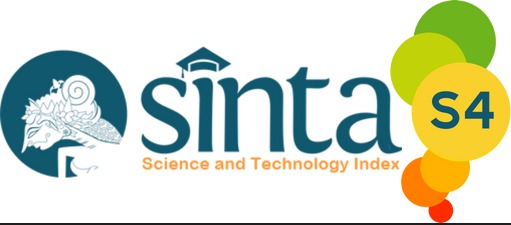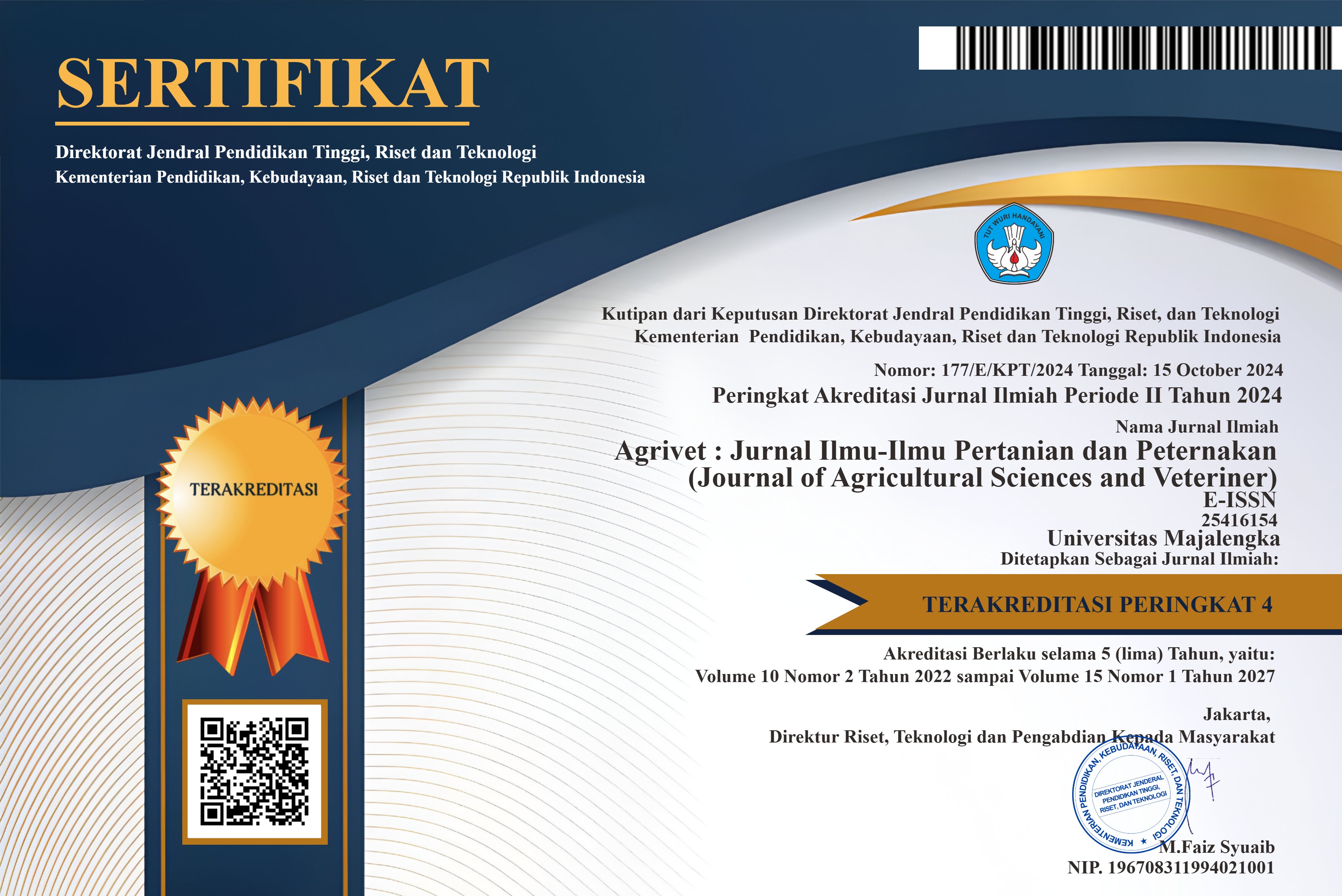Pengaruh pemberian pupuk Fe terhadap pertumbuhan, produksi, dan kelayakan ekonomi tanaman tomat (Solanum lycopersicum)
DOI:
https://doi.org/10.31949/agrivet.v13i1.13554Abstract
Plants require nutrients to carry out various essential physiological processes in their lives. Iron (Fe) is one of the important micronutrients that are essential for plant growth and reproduction. Although plants only need Fe in relatively small amounts, compounds containing Fe play a crucial role in various physiological processes. The purpose of this study was to determine the effectiveness of Fe fertilizer on yield and economic feasibility in tomato plants. The experiment was arranged in a randomized block design with 7 treatments and 4 replications. The treatments used were without inorganic fertilization (P0), comparison inorganic fertilization (P1), and 5 levels of inorganic Fe fertilization: 1.0, 1.5, 2.0, 2.5, and 3.0 l/ha of inorganic Fe fertilizer applied at 4, 6, 8, and 10 weeks after planting (WAP). The results of the experiment showed that the application of 1.25 doses of inorganic Fe fertilizer (2.5 l/ha/application) resulted in the highest plant growth and yield components and tomato yield compared to the control treatment. That treatment also showed the most effective dose agronomically and economically. The recommended dose for tomato plants is 2.5 l/ha/application applied 4 times, namely at 4, 6, 8, and 10 WAP by foliar spray.
Keywords:
hortikultura, Pupuk, ProduktivitasDownloads
References
Akbar, S. A. Q., Hifnalisa, H., & Muyassir, M. (2020). Teknologi Ameliorasi dan Pemupukan Tanah Suboptimal serta Hubungannya dengan Serapan Hara, Efisiensi Pemupukan dan Hasil Padi Galur Sikuneng. Jurnal Ilmiah Mahasiswa Pertanian, 5(2), 250-256.
Bashir, K., & Nishizawa, N. K. (2013). Iron proteins, plant iron transporters. Encyclopedia of metalloproteins, 1015-1023.
Bashir, K., Ishimaru, Y., & Nishizawa, N. K. (2011c). Identification and characterization of the major mitochondrial Fe transporter in rice. Plant Signaling & Behavior, 6(10), 1591-1593.
Bashir, K., Ishimaru, Y., Shimo, H., Kakei, Y., Senoura, T., Takahashi, R., ... & Nishizawa, N. K. (2011b). Rice phenolics efflux transporter 2 (PEZ2) plays an important role in solubilizing apoplasmic iron. Soil Science and Plant Nutrition, 57(6), 803-812.
Bashir, K., Ishimaru, Y., Shimo, H., Nagasaka, S., Fujimoto, M., Takanashi, H., ... & Nishizawa, N. K. (2011a). The rice mitochondrial iron transporter is essential for plant growth. Nature communications, 2(1), 322.
Hanke, G. U. Y., & Mulo, P. (2013). Plant type ferredoxins and ferredoxin‐dependent metabolism. Plant, cell & environment, 36(6), 1071-1084.
Hu, Y., Burucs, Z., & Schmidhalter, U. (2008). Effect of foliar fertilization application on the growth and mineral nutrient content of maize seedlings under drought and salinity. Soil Science and Plant Nutrition, 54(1), 133-141.
Islam, M. S., Kasim, S., Amin, A. M., Alam, M. K., Khatun, M. F., Ahmed, S., ... & Hossain, A. (2023). Foliar application of enriched banana pseudostem sap influences the nutrient uptake, yield, and quality of sweet corn grown in an acidic soil. PloS one, 18(8), e0285954.
Marschner, H. (1995). Mineral nutrition of higher plants.
Michel, L., Beyá-Marshall, V., Rombolà, A. D., Pastenes, C., & Covarrubias, J. I. (2019). Evaluation of Fe-heme applications or intercropping for preventing iron deficiency in blueberry. Journal of Soil Science and Plant Nutrition, 19, 117-126.
Mori, S., Nishizawa, N., Hayashi, H., Chino, M., Yoshimura, E., & Ishihara, J. (1991). Why are young rice plants highly susceptible to iron deficiency?. In Iron Nutrition and Interactions in Plants: “Proceedings of the Fifth International Symposium on Iron Nutrition and Interactions in Plants”, 11–17 June 1989, Jerusalem, Israel, 1989 (pp. 175-188). Springer Netherlands.
Obi, C. D., Bhuiyan, T., Dailey, H. A., & Medlock, A. E. (2022). Ferrochelatase: mapping the intersection of iron and porphyrin metabolism in the mitochondria. Frontiers in Cell and Developmental Biology, 10, 894591.
Pooja, A. P., & Ameena, M. (2021). Nutrient and PGR based foliar feeding for yield maximization in pulses: A review. Agricultural Reviews, 42(1), 32-41.
Rodríguez-Celma, J., Pan, I. C., Li, W., Lan, P., Buckhout, T. J., & Schmidt, W. (2013). The transcriptional response of Arabidopsis leaves to Fe deficiency. Frontiers in Plant Science, 4, 276.
Sun, W. J., Zhang, J. C., Ji, X. L., Feng, Z. Q., Wang, X., Huang, W. J., ... & Hao, Y. J. (2021). Low nitrate alleviates iron deficiency by regulating iron homeostasis in apple. Plant, Cell & Environment, 44(6), 1869-1884.
Tognetti, V. B., Palatnik, J. F., Fillat, M. F., Melzer, M., Hajirezaei, M. R., Valle, E. M., & Carrillo, N. (2006). Functional replacement of ferredoxin by a cyanobacterial flavodoxin in tobacco confers broad-range stress tolerance. The Plant Cell, 18(8), 2035-2050.
Van Hoewyk, D., Abdel-Ghany, S. E., Cohu, C. M., Herbert, S. K., Kugrens, P., Pilon, M., & Pilon-Smits, E. A. (2007). Chloroplast iron-sulfur cluster protein maturation requires the essential cysteine desulfurase CpNifS. Proceedings of the National Academy of Sciences, 104(13), 5686-5691.
Vigani, G., Zocchi, G., Bashir, K., Philippar, K., & Briat, J. F. (2013). Signals from chloroplasts and mitochondria for iron homeostasis regulation. Trends in Plant Science, 18(6), 305-311.
Published
How to Cite
Issue
Section
License
Copyright (c) 2025 Hafith Furqoni

This work is licensed under a Creative Commons Attribution-ShareAlike 4.0 International License.
An author who publishes in the Jurnal Agrivet agrees to the following terms:
- Author retains the copyright and grants the journal the right of first publication of the work simultaneously licensed under the Creative Commons Attribution-ShareAlike 4.0 License that allows others to share the work with an acknowledgment of the work's authorship and initial publication in this journal
- The author is able to enter into separate, additional contractual arrangements for the non-exclusive distribution of the journal's published version of the work (e.g., post it to an institutional repository or publish it in a book) with the acknowledgment of its initial publication in this journal.
- The author is permitted and encouraged to post his/her work online (e.g., in institutional repositories or on their website) prior to and during the submission process, as it can lead to productive exchanges, as well as earlier and greater citation of the published work











